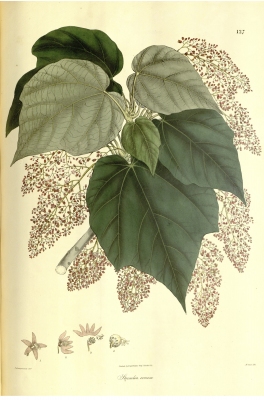Sterculia comosa
Wall.
Malvaceae
Cavallium comosum (Wall.) Schott & Endl.
Clompanus comosa (Wall.) Kuntze
Sterculia keyensis Warb.
Sterculia philippinensis Merr.
Sterculia ramosii Merr.
Sterculia wigmanii Hochr.
Common Name:

Illustration of leaves and flowers from Plantae Asiaticae Rariores, vol. 2- t.127 (1831) [Vishnupersaud]
Photograph by: Swallowtail Garden Seeds

General Information
Sterculia comosa is a tree growing up to 30 metres tall. The bole can be 65cm in diameter[
345- Title
- Minor Products of Philippine Forests
- Publication
-
- Author
- Brown. W. H.
- Publisher
- Bureau of Forestry, Manilla.
- Year
- 1920
- ISBN
-
- Description
- A useful guide to some of the plants of the area, though terse on details. The book is out of copyright and can be legally downloaded from the Internet.
].
The tree is harvested from the wild for local use of its fibre and wood.
Sterculia comosa has a very wide distribution, large population, is not currently experiencing any major threats and no significant future threats have been identified.The plant is classified as 'Least Concern' in the IUCN Red List of Threatened Species(2019)[
338- Title
- IUCN Red List of Threatened Species
- Publication
-
- Author
-
- Website
- http://www.iucnredlist.org/
- Publisher
-
- Year
- 0
- ISBN
-
- Description
- A list of plants under threat and facing possible extinction, usually with brief details of the threats and information on habitat.
].
Known Hazards
None known
Botanical References
Range
Southeast Asia - Philippines, Indonesia (Maluku, Sulawesi).
Habitat
Rainforests[
345- Title
- Minor Products of Philippine Forests
- Publication
-
- Author
- Brown. W. H.
- Publisher
- Bureau of Forestry, Manilla.
- Year
- 1920
- ISBN
-
- Description
- A useful guide to some of the plants of the area, though terse on details. The book is out of copyright and can be legally downloaded from the Internet.
].
Properties
| Conservation Status | Least Concern |
| Other Uses Rating |      |
| Habit | Tree |
| Height | 30.00 m |
| Cultivation Status | Wild |
Cultivation Details
Not known
Edible Uses
Although we have seen no specific information for this species, the large seeds of many species in this genus are used for food. Usually cooked, they are rich in oil and have a flavour described by some as like peanuts[
K- Title
- Plants for a Future
- Author
- Ken Fern
- Description
- Notes from observations, tasting etc at Plants For A Future and on field trips.
].
Medicinal
None known
Other Uses
A fibre is obtained from the bark. It is used for making rope[
345- Title
- Minor Products of Philippine Forests
- Publication
-
- Author
- Brown. W. H.
- Publisher
- Bureau of Forestry, Manilla.
- Year
- 1920
- ISBN
-
- Description
- A useful guide to some of the plants of the area, though terse on details. The book is out of copyright and can be legally downloaded from the Internet.
].
We have no specific description for the wood of this species, but the following is a general description of the wood of Sterculia species in the Phillipines:-
The fresh wood is creamy white or very light gray or brown, but almost invariably staining to a silvery gray or a light brown; the sapwood is scarcely if at all distinguishable from the heartwood. The texture is coarse, spongy; the grain straight. The wood is soft to very soft; light to very light in weight; The durability is very poor; the wood being frequently attacked by beetles, though the heartwood, if seasoned rapidly and thoroughly, is somewhat better than the sapwood. Except for staining, the wood seasons well; it is very easy to work. Of low quality, it is used for cheap and temporary construction, box lumber, etc.; temporary mining timbers. It has been recommended for trial as match wood[
721- Title
- Commercial Woods of the Philippines; Their Preparation and Uses
- Publication
- Philippines Bureau of Forestry Bulletin No. 14
- Author
- Schneider E.E.
- Website
- http://www.biodiversitylibrary.org
- Publisher
- Bureau of Forestry; Manilla.
- Year
- 1916
- ISBN
-
- Description
- A series of booklets dealing with various aspects of the Philippine forests. This volume looks at the preparation and uses of the commercial woods of the Philippines. It can be downloaded from the Internet.
].
Propagation
A physical dormancy caused by the hard seed coat of the mature seeds of many species in this genus can be overcome by scarifying the seed. This is carried out by cutting away or abrading some of the seed coat to allow the ingress of water, though great care must be taken not to damage the embryo[
]. The aril surrounding the seed should also be removed - this is easiest when it has been softened through soaking in water[
]. The seeds germinate optimally at temperatures between 20 - 30°c. They can be sown in a nursery seedbed or in containers. A germination rate of about 95%, occurring within about 2 weeks can be expected if the seed has been properly treated[
].
If you have any useful information about this plant, please leave a comment. Comments have to be approved before they are shown here.


 Useful Tropical Plants Database 2014 by
Ken Fern,
web interface by
Ajna Fern
with help from
Richard Morris.
Useful Tropical Plants Database 2014 by
Ken Fern,
web interface by
Ajna Fern
with help from
Richard Morris.